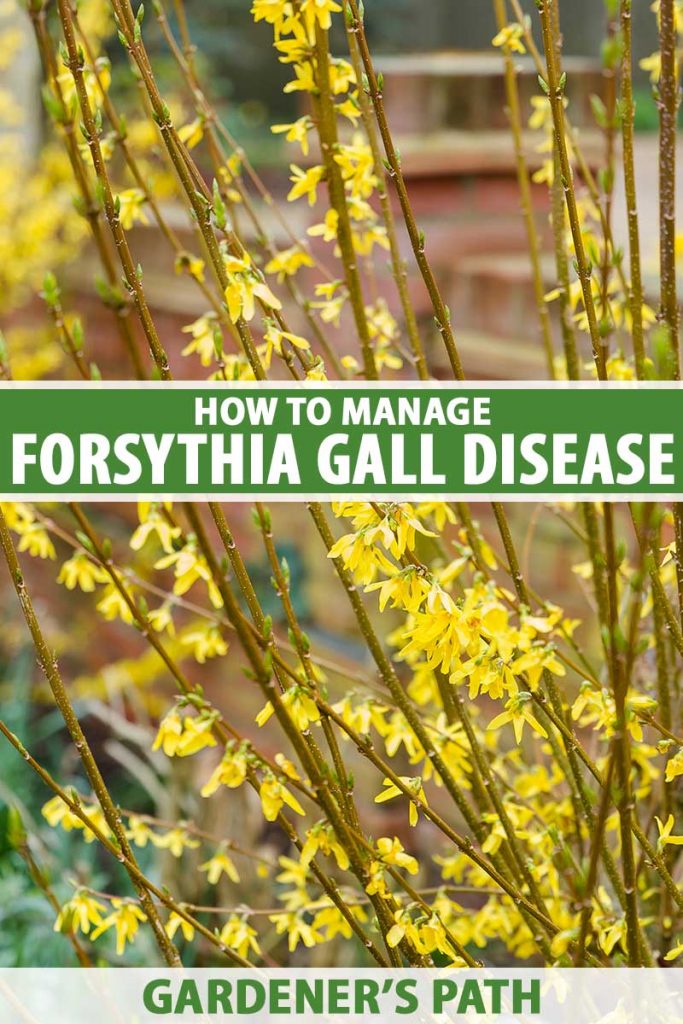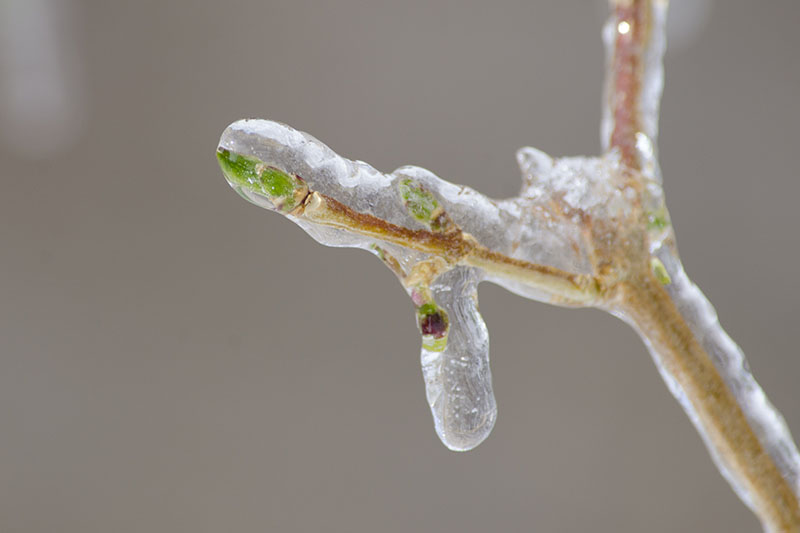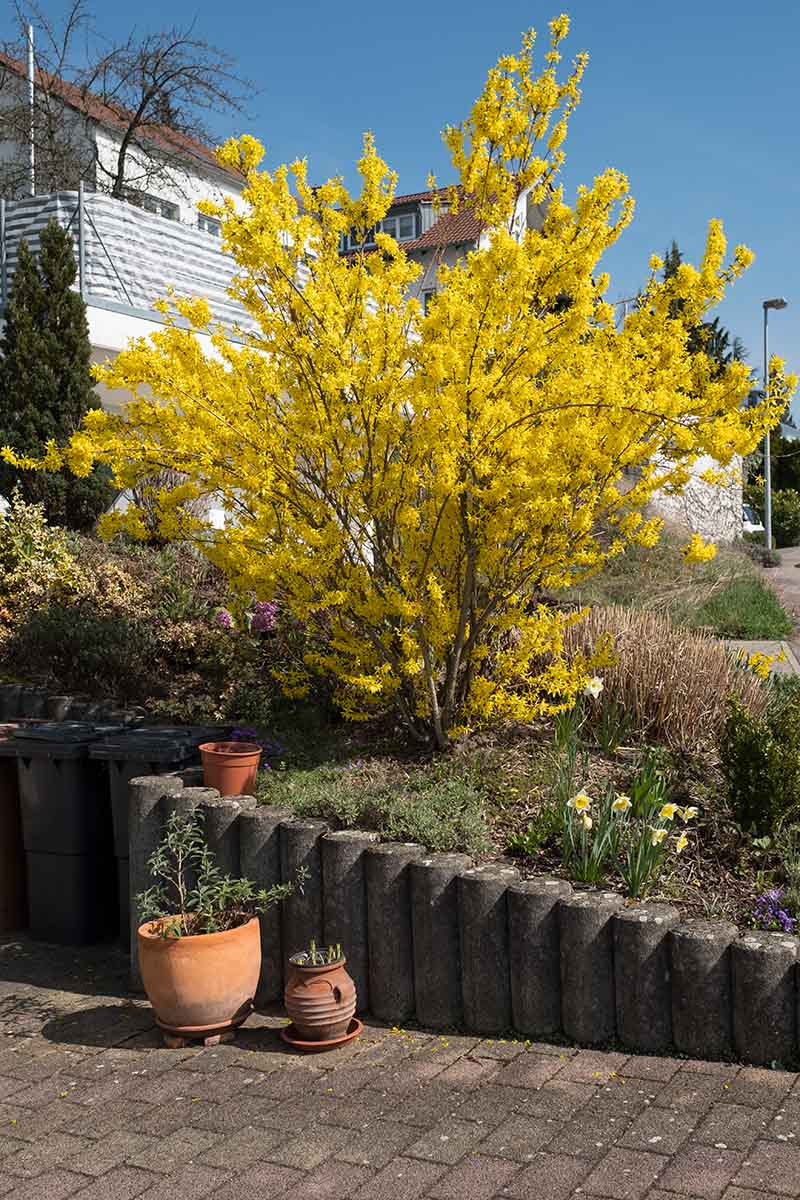It is a low-maintenance, robust plant that tolerates a variety of growing conditions, from dense clay soil to the juglone toxicity of black walnut trees. Occasionally, this sturdy shrub develops knot-like, woody deformities called galls that may appear either individually or in clusters along the stems. We link to vendors to help you find relevant products. If you buy from one of our links, we may earn a commission. In our guide to growing forsythia, we discuss all you need to know to cultivate this shrub in your landscape. In this article, we talk about what forsythia gall disease is and how to address it. Here’s what we’ll cover: Any type of plant irregularity is a red flag. It’s important to evaluate any strange growth behavior that you notice, as it may turn out to be a disease that not only threatens the affected plant, but those nearby as well. Let’s get started.
What Is Forsythia Gall Disease?
There are multiple types of swellings or growths that can appear on plants. Some may look like raised bumps on the leaves, others like smooth balloons on the branches. They can pop up on flowers and foliage that have been chewed by sap-sucking insects, and even on roots infested with soilborne parasites. Feeding bugs can spread bacterial, fungal, and viral infections that can stimulate plants to develop abnormal, raised growths that may appear bumpy, knotted, or swollen. And while we know a lot about those caused by vectors such as aphids, mites, and root-knot nematodes, we know far less about the specific cause of forsythia galls. To me, this type of growth looks like a thick clump of yellowish-brown flower buds, but instead of being tender to the touch, they are firm. Described as knobby, knotty, and woody, these formations represent the presence of a disease of unconfirmed origin. An article from the Cornell University College of Agriculture and Life Sciences Plant Disease and Diagnostic Clinic, updated in 2015, describes three causative factors believed to be responsible for producing nodular growth on forsythia, either individually or in combination: Agrobacterium tumefaciens, aka Rhizobium radiobacter, and A. radiobacter are soilborne bacteria that cause crown gall growth, at the point where the roots meet the stems. Phomopsis is a genus of gall-inducing ascomycete fungal pathogens (aka sac fungi) that contains numerous species that affect the foliage and wood of a variety of different trees and shrubs. A genetic abnormality may predispose forsythia to gall formation. Additionally, a study conducted in 2017 revealed that there is in fact a new potential culprit: Pseudomonas savastanoi – a pathogen known to be responsible for the development of cankers in olive and ash trees. P. savastanoi is known as a gammaproteobacteria, which means that under a microscope it has a rod-like shape. It’s also endophytic, meaning it lives and multiplies inside plant tissue. Some endophytic bacteria and fungi may have a beneficial effect on the host plant – or, as in this case, cause abnormalities. According to Doctor of Plant Medicine Raj Singh at the Louisiana State University AgCenter, in an article on gall-causing Pseudomonas savastanoi bacteria as it pertains to Loropetalum (witch hazel) and one of its common hosts, forsythia, “After the initial infection, galls may start to appear in two to three months.” They gradually enlarge, and there may be multiple nodules on the same stem. Regardless of the source, when a plant plays host to fungi or bacteria known to cause galls, these growths are most likely to form if plant tissue is already compromised. This weakness may come in the form of broken stems, frost-bitten buds, moisture saturated foliage, damaged roots, insect infestation, or a combination of these and possibly other factors as well.
Galls may start out small, and there may be one or more along a length of stem. When they enlarge and begin to merge with one another, they can surround an entire stem like a ring, or girdle. Over time, this can cause wilting, stem dieback, and in severe cases, shrub death. To date, there is no effective treatment for forsythia galls. So, what can we do?
Proactive Avoidance Measures
With best garden practices, we can minimize the risk of contracting this deforming, potentially fatal disease.
To begin with, always purchase quality shrubs from reputable purveyors. If you buy in person, examine them for signs of good health and the absence of abnormal growth before making your selections. When planting shrubs, take into account their mature dimensions and space them appropriately to allow for optimal airflow. Even shrubs used to create hedges need to have room to grow to their full widths without crowding their neighbors. Water at the soil level to avoid wetting the leaves and creating a breeding ground for fungal growth. Disinfect pruning shears both before and after use. Sanitary tools go a long way toward preventing the spread of disease. The pros of the Integrated Pest Management Program of the University of Missouri recommend using 70 percent isopropyl alcohol directly from the bottle, or a 10 percent bleach solution made with one part household bleach to nine parts water. Do not under any circumstances mix the alcohol and bleach solution together. When you are cutting stems for pruning purposes or flower arranging, avoid doing so during wet weather. Cutting opens wounds that are vulnerable to penetration by moisture-loving pathogens. Prune shrubs immediately after flowering and remove any dead or dying branches to maintain airflow and avoid the build up of moisture and humidity around the plant. Purge weeds and remove debris around shrubs to inhibit insect infestations that can weaken plants and make them susceptible to disease. Forsythia is a non-native plant that is not prone to insect infestation, but if you notice eggs or bugs, apply neem oil or an insecticidal soap per package instructions. Avoid accidental damage to plant tissue by keeping string trimmers (weed whackers) and mowers far from lower stems. Similarly, try not to damage roots by inadvertently digging a new garden bed or sinking fence posts too close to them.
Caring for Affected Shrubs
If you see galls, don’t panic. They are easily removed in one of two ways. Some folks like to cut off the affected stems to their points of origin. Others prefer to preserve as much of each stem as possible, by cutting them four to six inches below each irregular woody mass, and leaving the rest intact. If you have a shapely hedge and only a few knotty places, you may want to keep the pruning to a minimum. For more extensive disease along the stems, you may need to remove entire lengths. Remember to sanitize your pruning shears as discussed above. Seal up all pruned stems and place them in the trash. Some folks burn them, but we’re not all zoned for such a disposal method. Forsythia is a fast grower, so recovery should be swift. However, if galls are persistent and the stems are chronically wilted or failing to regenerate, it may be wise to remove entire shrubs from the garden and dispose of them. If you remove a heavily diseased or dead shrub, it is recommended not to plant another forsythia or other gall-prone plant in the same location until scientists conclusively confirm the absence or presence of a soilborne causative factor. Examples include fruit trees and roses. In addition, it is not a good idea to propagate new plants with stem cuttings from shrubs known to have harbored disease. This is because of the wildcard: genetic predisposition. Until proven otherwise, it’s possible that there’s a pre-wired vulnerability to the disease in the DNA of plants in the Forsythia genus.
The best we can do for these blossom-laden harbingers of spring is to use our best gardening practices to avoid triggering it, remove affected stems – and entire shrubs if necessary – when it rears its ugly head. Have your forsythia plants suffered from galls? Let us know in the comments section below! If you found this article informative and are interested in learning more about growing forsythia, check out these articles next:
7 Reasons Why Forsythia May Not Bloom 11 of the Best Forsythia Varieties for Glorious Spring Color 5 Common Causes of Forsythia Yellowing 7 Tips for Growing Formal and Informal Forsythia Hedges
© Ask the Experts, LLC. ALL RIGHTS RESERVED. See our TOS for more details. Uncredited photos: Shutterstock.






